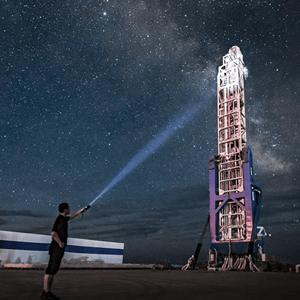Chinese Space Industry’s New Achievement Makes Musk Helpless
On June 23, 2024, the new experimental reusable rocket developed by the No.8 Institute of China Aerospace Science and Technology Corporation (CASC) successfully conducted a 10-kilometer-level flight test at the Jiuquan Satellite Launch Center.
 The experimental reusable rocket successfully finished its 10-kilometers-flight test. | Source: CASC
The experimental reusable rocket successfully finished its 10-kilometers-flight test. | Source: CASC
During the test, the rocket was propelled by three variable-thrust liquid oxygen-methane engines. When it rose to an altitude of about 12 kilometers, the rocket shut down the engines on both sides, adjusted the thrust of the central engine, and began a controlled fall. At 50 meters above the ground, the rocket deployed its four landing legs, then slowly declined and landed steadily on the recovery field, achieving a fixed-point vertical soft landing. The test was a complete success! CASC commented that this test “laid the technical foundation for the first flight of a 4-meter-class reusable rocket as scheduled in 2025.”
 CASC’s experimental reusable rocket | Source: CASC
CASC’s experimental reusable rocket | Source: CASC
Why does China want to develop reusable carrier rockets? When will China have a “complete” reusable rocket similar to the US Falcon 9? What is the competition and cooperation pattern in the industry? This article will briefly discuss these questions.
As early as the early 1960s, through rigorous demonstration, aerospace scientists including Qian Xuesen argued that rocket recovery and reuse can greatly improve turnover efficiency and reduce costs. However, since the development of related fields such as computing power, materials, aerodynamics, control, technology, and even decision-making and management has not yet reached the ideal level, engineering practice has not been smooth sailing. For example, the space shuttle developed by the United States in the 1970s was designed with only the external main fuel tank as a disposable product, and no engines were discarded. Its degree of reuse has never been matched among spacecraft that have been put into orbit. However, because the developer seriously underestimated the comprehensive cost of the product, the project was not profitable, and the space shuttle was eventually retired in 2011 with a large amount of theoretical life remaining.
 American Space Shuttle Endeavour displayed in California Space Center | Source: Space.com
American Space Shuttle Endeavour displayed in California Space Center | Source: Space.com
After 2010, rocket recovery and reuse technology finally achieved practical breakthroughs. For example, the main carrier of SpaceX, the Falcon 9 rocket, can adjust its attitude and ignite several times after completing its mission to land vertically on land or a drone ship. After inspection and maintenance, it can be reused. So far, a single booster has set a record of 21 flights. With just over a dozen first-stage boosters, SpaceX conducted 96 orbital launches in 2023, far surpassing any other country or commercial space entity worldwide. The price for a single rocket with a payload capacity of nearly 20 tons has been reduced to over 50 million USD, almost the lowest in the world. In addition to SpaceX, Blue Origin has also achieved the reuse of rockets reaching an altitude of 100 kilometers, used for servicing the New Shepard suborbital manned spacecraft.
 Falcon 9 Rocket | Source: SpaceX
Falcon 9 Rocket | Source: SpaceX
Vertical rocket recovery is a technology that requires the deep integration and close interconnection of various disciplines, such as control, structure, propulsion, aerodynamics, navigation, and communication, where a change in one aspect can affect the entire system. This technology has only seen comprehensive development in the past decade and has limited global technical accumulation. To verify the relevant designs at a relatively low cost and in a sequence from simple to complex and from primary to secondary aspects, SpaceX conducted the first flight of the “Grasshopper” takeoff and landing prototype in 2012. The Grasshopper was composed of fuel tanks, a single Merlin 1D engine used in the Falcon 9 rocket, and fixed landing legs. From 2012 to 2013, this rocket conducted eight successful vertical takeoff and landing tests at a test site in New Mexico, with flight altitudes gradually increasing from 1.8 meters to 744 meters. Subsequently, SpaceX developed the Falcon 9R Dev1 prototype, which used the actual rocket body, increased the number of engines to three, and switched to retractable landing legs. Four test flights were conducted in 2014. Benefiting from these preliminary tests, SpaceX successfully recovered the first-stage booster for the first time on December 21, 2015.
 Falcon 9R Dev1 Prototype | Source: SpaceX
Falcon 9R Dev1 Prototype | Source: SpaceX
Referring to SpaceX’s approach, Chinese companies have also chosen to start with prototypes. For example, in the test conducted on June 23, the product from the CASC No.8 Institute skipped the “Grasshopper” phase and directly reached the level of the Falcon 9R Dev1 on its maiden flight. This progress has laid the technical foundation for the first flight of a reusable launch rocket with a 4-meter diameter by 2025. Within this year, the experimental rocket also plans to conduct a test at an altitude of 75 kilometers, simulating the full flight of a first-stage booster, thereby completing the final step before the official attempt.
In addition to state-owned enterprises, China’s private enterprises are also making rapid progress. On January 19, 2024, LandSpace’s ZQ-3 experimental reusable vertical take-off and landing rocket successfully completed a 300-meter flight on its first test flight, reaching the level of SpaceX’s “Grasshopper” sixth test. LandSpace also plans to conduct a 10-kilometer test in the near future.
 ZQ-3 Experimental Reusable Rocket | Source: LandSpace
ZQ-3 Experimental Reusable Rocket | Source: LandSpace
In addition, China Aerospace Science and Industry Corporation (CASIC), Link Aerospace, Deep Blue Aerospace, Interstellar Glory, and other enterprises have also carried out reusable rocket tests. China’s reusable rocket research and development has shown the characteristics of a high starting point, rapid progress, and diverse corporations, laying a good foundation for early practical use. At present, except for China and the United States, no other country has carried out 100-meter-level rocket vertical take-off and landing tests.
In addition to technology, China’s reusable rocket test on June 23, 2024, has another feature that is different from its American counterparts, that is, “cooperation between state-owned and private enterprises.”
The rocket was developed by CASC No.8 Institute, and the 70-ton thrust liquid oxygen-methane engine used came from the private enterprise Jiuzhou Yunjian. “70 tons” is in the ideal thrust range for reusable rockets, and “liquid oxygen-methane” is internationally recognized as a clean reusable fuel for the future. Based on factors such as performance, time, and price, CASC’s No.8 Institute chose to outsource key products, and ultimately achieved good results, reflecting the efficiency-first commercial aerospace strategy.
This model, combining self-R&D and outsourcing, does not align with SpaceX’s advocated approach of “supply chain autonomy.” The background of the latter is rooted in the conflict between Elon Musk’s extreme pursuit of production efficiency and the expensive and inefficient production modes of NASA. Only through complete self-R&D can SpaceX effectively resolve this contradiction. However, in China, after years of competitive iteration, a number of high-quality state-owned and private enterprises have emerged. Taking commercial reusable liquid engines as an example, there are currently at least seven companies capable of supplying products with thrust in the “golden range” (50-100 tons) to the market. These companies include CASC, CASIC, LandSpace, Space Pioneer, Galactic Energy, Jiuzhou Yunjian, and Interstellar Glory (in no particular order). They cover both major routes of liquid oxygen kerosene and liquid oxygen methane.
There are already practical transaction cases combining self-R&D and outsourcing. For example, in April 2023, the private company Space Pioneer successfully conducted the maiden flight of its TL-2 rocket, breaking the curse that the first launches of liquid rockets by seven worldwide emerging aerospace companies all failed since SpaceX. This rocket used the Liquid Engine 102 developed by CASC. The recent June 23 test marked the first time a state-owned enterprise procured engine products from a private company.
Successful cases combining independent and integrated R&D illustrate that China’s commercial space industry might have a development path different from Elon Musk’s approach. Like the cellphone and automobile industry, China can fully utilize its comprehensive national industrial capabilities through the division of labor and collaboration. This allows for optimizing the supply chain on the largest possible scale (even beyond the industry) and sharing the fruits of development.
After all, the goal is not “being like Elon Musk” but to raise efficiency. As the industry progresses, China’s commercial space sector will undoubtedly find a path more suited to its national circumstances.




